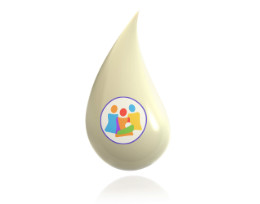Human Milk Storage
Updated 04/22
PDF Version
Prior to Expressing Milk with a Breast Pump
- Wash your hands with soap and water. Use hand sanitizer (at least 60% alcohol) if you cannot wash your hands.
- Ensure the pump and pump parts are clean. Discard and replace moldy tubing immediately.
- If you are using a shared pump, wipe the dials, power switches, and surrounding area with a disinfectant wipe.
Containers for Expressed Milk
- Breast milk storage bags or clean, food-grade containers that are BPA-free may be used to store your expressed milk. Glass or plastic bottles with well-fitting lids should be used. Label the containers with the date it was expressed, and the infant’s name if needed for daycare.
Storing Expressed Milk
Storage Location and Temperatures (CDC Guidelines)
| Type of Human Milk | Countertop or Room Temperature (≤77°F or ≤25°C) | Refrigerator (≤40°F or ≤4°C) | Freezer (≤0°F or ≤-18°C) |
|---|---|---|---|
| Freshly Expressed or Pumped Milk | Up to 4 hours | Up to 4 days | Within 6 months is best. (Within 12 months is acceptable.) |
| Previously Frozen (Thawed) Milk | 1-2 hours | Up to 1 day (24 hours) | Do NOT refreeze thawed milk. |
| Leftover from a Feed (Baby didn’t finish their bottle) | Use within 2 hours of finishing the feed. | ||
- Milk can be stored in a cooler with frozen ice packs for up to 24 hours when at work or traveling. Use, refrigerate, or freeze the milk as soon as possible once you are at home or reach your destination.
- Freeze fresh milk within 4 days from the date of expression to make sure the frozen milk is of the best possible quality.
- Freeze your milk in amounts that your baby will take in one feeding, this is typically 2-4 ounces (or 60-120 ml). After 6 weeks of age, your baby will typically take approximately the same volume per feeding.
- Leave 1 inch of space at the top of the container prior to freezing since milk expands as it freezes.
- Avoid storing milk in the freezer door to protect it from temperature changes due to opening and closing the freezer door.
Safely Thawing Frozen Milk
- Thaw the oldest milk first when you are ready to use it. There are 3 recommended options for thawing the milk:
- In the refrigerator overnight.
- Place the container in a warm water bath.
- Place the container under running warm water.
- If the milk was frozen in a storage bag, you may want to place it in another container before placing in a warm water bath or under running water, in case there are tiny punctures in the plastic bag.
- Do NOT microwave human milk. This can destroy nutrients in the milk. It can also cause hot spots that can burn your baby’s mouth.
- Once the milk is 100% thawed, use it within 24 hours.
- Once the milk is at room temperature, use it within 2 hours.
- Do NOT refreeze human milk.
Common Questions
Why does my milk smell or taste soapy?
Sometimes thawed milk may have an off-odor or taste soapy. This is a normal change due to an enzyme called lipase in the milk. An off-odor does not indicate that the milk is ‘bad’. Everyone has lipase in their milk, and there is no evidence that people have ‘high lipase’. Lipase naturally breaks down the fat in breastmilk as soon as the milk leave the body, to help the baby digest the fats. If the milk does not go into the baby but rather into a bag or bottle, lipase does not know the difference, and it gets to work, breaking down the fat.


